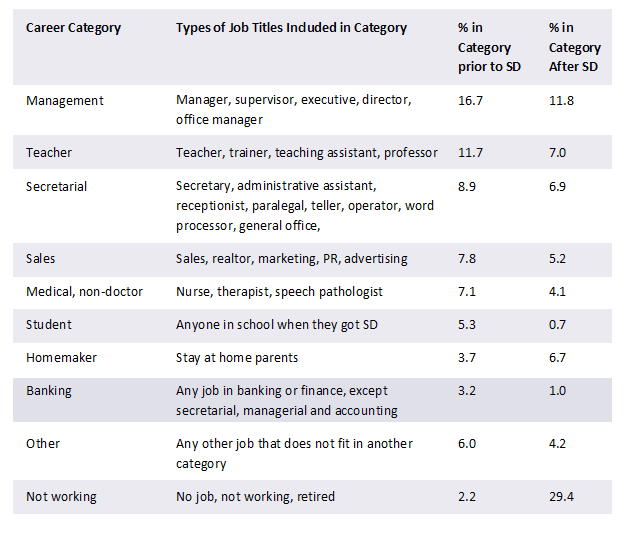An organization’s workforce is its most valuable asset
Voice issues can impact all facets of a person’s life, including career. That’s why it is important to be knowledgeable about your choices to navigate any changes effectively.
A survey of 700 individuals with spasmodic dysphonia offers insight into how a voice disorder can impact one’s employment. They were asked about their job before diagnosis and after diagnosis. More than one-quarter of survey participants said they had to change jobs because of their symptoms, meaning voice impacted the economic opportunity and career path of those with SD.

Supporting those with disabilities makes good business sense
The National Organization on Disability (NOD) reports that more than 54 million Americans have a disability and that individuals with disabilities comprise 7% of the workforce. The Americans with Disabilities Act (ADA) of 1990 was conceived with the goal of integrating people with disabilities into all aspects of life. Sensitivity toward people with disabilities is not only in the spirit of the ADA, it makes good business sense. It can help you expand your practice, better serve your customers or develop a larger audience for your products. A person living with a voice disorder can be seriously impacted professionally. Imagine being in sales, public speaking, teaching, and the many careers where verbal communication is key, then developing a disorder that impacts your ability to communicate with ease.
When you employ disabled workers, not only do you reap the benefits of a skilled staff, but you also build a diverse workforce and foster a culture of tolerance and respect.
Building a structure to support a diverse workforce
Increasingly, companies are establishing internal organizational structures to address the unique needs and issues of those with all disabilities in the workforce. In order to build a workplace that embraces all people equally, there needs to be an action plan that encompasses the following:
- Top Management Support
- Organizational Policies
- Manager Training
- Individual Training
Top Management Support
Recognizing that diversity (physical abilities, race, age, religion or gender) is a source of strength is an important message for top management of any company to convey. With top management support, it also means that the resources are available to impact how the company builds tolerance. Establishing a zero tolerance approach toward offenders is also important.
Organizational policies
In order to give importance to diversity in the workplace, it is important to create organizational policies that state your commitment in all aspects of employment. The policy should be written, included in the employee handbook, and focuses on these main aspects:
– Gives your clear statement and commitment to practices that promote inclusion of all people regardless of race, age, physical ability, religion or gender. This statement represents your organizational values.
– Addresses key objectives for your workplace
– Emphasizes leadership’s role in encouraging diversity
– Reinforces compliance
EARN | Fostering an Inclusive Workplace
DOL | Inclusion at work resources
Manager Training
Manager training should include:
– Compliance training
– Recognizing the strength in diversity
– Recognizing issues
– Addressing opposition to change
Individual Training
Individual training should include:
– Building awareness
– Practicing personal interaction techniques
– Understanding prejudice and stereotypes
– Providing an inclusive workplace builds productivity
– Establishing a zero tolerance policy
Employee Resource Groups
An Employee Resource Group (ERG) is often established at companies to address the internal needs of those who have disabilities. In fact 90% of all Fortune 500 companies have a group and most have an executive sponsor or CEO participation. An ERG can be instrumental in improving the workplace culture and shed light on issues within the organization that are related to disabilities.
EARN | Creating an Employee Resource Group
Stay-at-Work and Return-to-Work Programs
Since SD and other vocal disorders can have an onset period, it can require a complete reorientation of roles by the individual. Employers should consider stay at work/return to work programs to support those newly diagnosed.
EARN | Resources for stay at work/return to work programs


